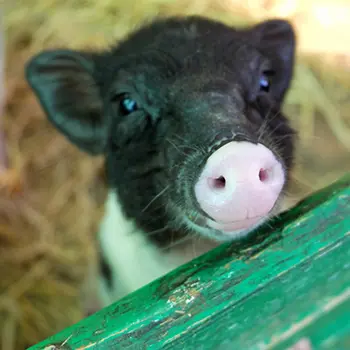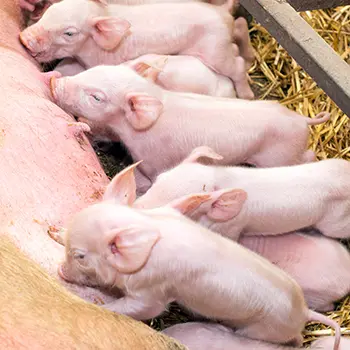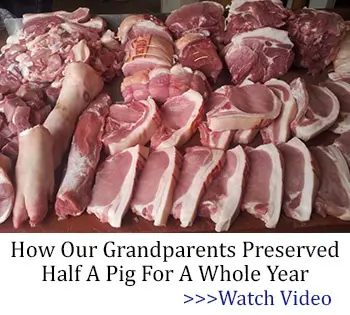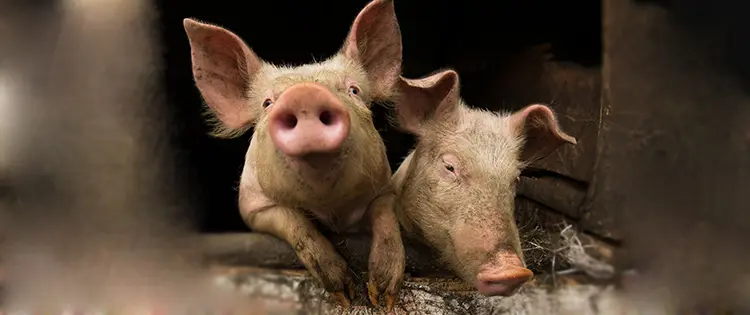Pigs are often some of the entry-level hoofstock that newer homesteaders get into. They then soon find that raising pigs is a completely different situation than working with poultry or rabbits.
Today, I’ll split this into two groups: miniature pigs and full-sized pigs. Hogs, like the American Guinea Hog, will not be covered just because they are a hog, not a pig, and therefore require a slightly different diet and different care. If you want to know more about miniature hogs and full-sized hogs, keep an eye out. I’ll do an article about them very soon. As for now, let’s get started on these pigs.
Miniature Pigs
Miniature pigs run the gamut from Julianas to Kune Kunes and everywhere in between. Potbellies are common, too.
I’m going to assume that you’re starting out with a boar and two sows; the makings of your own herd and easily workable in most small landholdings.
Miniature pigs are often fed a diet of grass, other types of forage, or, when those two things are not available, hay. They are also an excellent type of pig to feed your kitchen scraps to, whole corn, and a commercial feed specifically made for pigs and hogs. Please note, I do not recommend “miniature pig feed” because bluntly, it is a gimmick rather than a specially-formulated type of food for your new oinky friends. The only real difference is that the pellet is smaller than typical pig feed.
If your pigs are having problems eating their feed because they are incredibly small, it may be worth considering these smaller-pellet feeds. Otherwise, stick with full-sized feed pellets and avoid the upcharge.
Related: Pig
Fencing can be tough with pigs. Though I’ll go over more aggressive rooters in the next section, even small pigs can rip a field to pieces in a pretty short amount of time; and then they’re going to want to go elsewhere. Your options are as follows: put a strand or two of electric fencing with a heck of a big jolt along the bottom of your fence line to keep your pigs in, or ring them.
I realize that most people do not want to ring their pigs. Placing a ring in their nose to prevent them from rooting more than an inch or two below the surface of the soil certainly seems cruel. It hurts. They scream. Even when done carefully, they still hate being restrained.
However, if your pigs are escape artists and force their way out (as some do even through electric fences), it may be a necessity. A properly applied ring does not hurt your pig, it is simply uncomfortable if they start trying to dig out from under a fence; enough so that they will stop doing it and return to their feed or trundling around as pigs do.
I recommend checking with your veterinarian for locally-required pig vaccines as each state (and sometimes each county) has a different requirement.
Full-Sized Breeds
Well, you’ve got yourself in the slop. You may as well have a party with it.
Teach your young piglets to respect you from the first off. You will have hundreds of pounds of hard-to-catch animals very, very quickly. Unless you have a full working setup for restraint, farrowing dystocia, vaccines, and trimming hooves; all the stuff you’ll need to do to take care of your pigs will be an absolute nightmare.
When talking about full-sized pigs, I tend to use “cow logic”. This animal will be too large for most restraint systems unless specifically made for it. The full-sized pig will rip straight through a cattle panel or a gate without even noticing it. Indeed, they’ll happily shred your fences, too unless made out of cinderblocks or concrete.
That is, unless you’re putting up some seriously hot electric fence or you have a 20+ acre area for them to explore.
Full-sized pigs should be befriended if at all possible. Give them treats from a pan you’re holding (never from your hand unless you want to be bitten; they won’t mean to, but those big snouts get them in trouble). Scratch their armpits and watch them flop over and give happy grunts. Buddy up to them and they’re much more easily handled.
Additionally, buy your feed via the pallet or the ton if at all possible. Full-sized pigs will go through a great deal of feed very, very quickly.
Ringing a full-sized pig is usually a permanent placement done by a vet. Speak to yours and see what they have to say on the matter based on what they see on your farm.
A Few Words on Farrowing
Like freshening and lambing, farrowing is the term for when a pig is giving birth.
If you have a trio (or a quad, or what have you) and you’re giving your pigs good nutrition, piglets will inevitably come along. Most pigs can breed as early as five to six months old, but it is better to go ahead and let them wait until they’re closer to a year old (or a little over for miniature breeds).
Honestly, whether you’re raising your piglets for meat or to sell for profit, almost everything is the same. I’ll do a deeper look at farrowing in the future (and link it here when I do), but for the moment:
- Make sure you have an emergency vet that can show up. PIglets are great at getting stuck in the birth canal and sows will rupture their uterus trying to get them out.
- Have injectable iron on hand. Many piglets are anemic at birth.
- Have pig milk on hand (or unimilk) just in case mom’s milk takes a while to come in.
- A heat lamp is usually very appreciated by the mother and the piglets.
- Pig rails are a necessity in the farrowing pen. They stop the mom from accidentally rolling onto the piglets. Make sure you have them.
Pigs in the House
Though the trend seems to be dying down (as of this writing), miniature breed pigs in the house were a huge fad for a little while. The images of pigs doing dog agility or sleeping snuggled down next to a fire were charming.
Pigs are not house pets. No matter what you’ve read or seen, they will not love living inside full-time. They tear through drywall, rip up electrical wires (possibly causing fires), and scream. They scream more than your aunt’s cockatoo ever thought about screaming.
So keep your pigs outside and let them be pigs. If you want, if you have a particularly special one that seems to enjoy its time inside, feel free to install a piggy door to let them come in; but don’t try to force the issue.
Have you kept pigs? What do you have to say about them? Hit us up in the comments below!
You may also like:
6 Small Animals You Can Raise On Your Property
Do you know why you should never put a tall fence around your house? (Video)
Livestock Animals You Should Start Raising For The Upcoming Economic Crisis














